Restoring Dunkirk's King Neptune Fountain
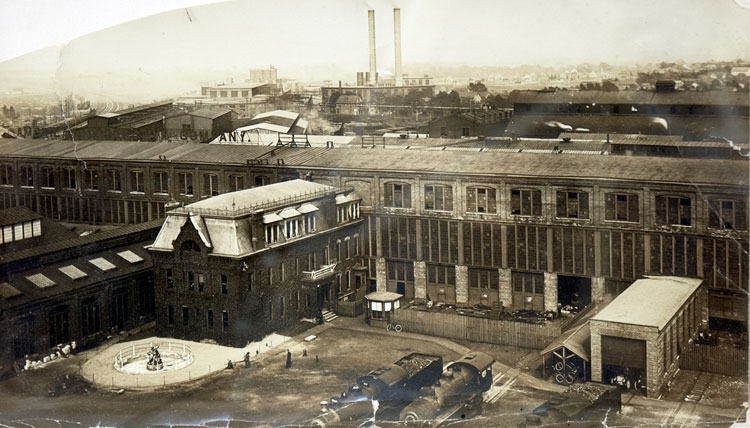
1920s view of the American Locomotive Works (aka Brooks), showing the Neptune fountain lower left in front of the administration building. Image credit: Robert Harris Collection, Dunkirk Historical Society.
Horatio Brooks, founder of the Brooks Locomotive Company in Dunkirk, built an office building to serve his expanding company and, in 1883, installed a fountain of King Neptune in front of the building. It weighed 960 pounds of a zinc composite, stood 7 feet tall, and cost him $500.
The fountain was sold by the J.W. Fiske Company, located at that time on 26 & 28 Park Place in New York City. The 20-year old company was in the forefront of a burgeoning industry in zinc scultpure, making fountains, garden sculpure and benches, memorial statues for fallen heroes for public and private customers.
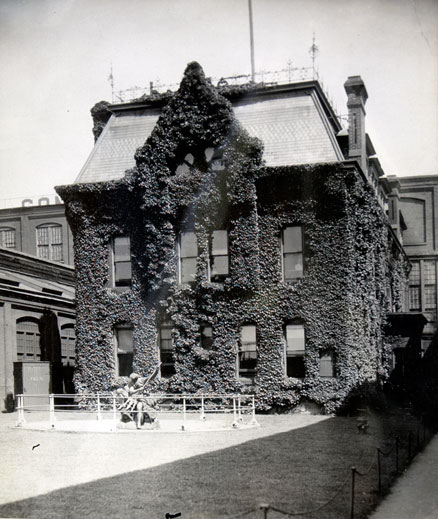
1924 photo of the administration building and fountain.
Image credit: Dunkirk Historial Society
The Fiske Neptune fountain was nearly identical to one sold by competitor, J.L Mott. Both were likely based on a model originally sculpted in France by Vital-Gabriel Dubray (1813-92). The fountain in front of the Brooks office building was cast in Pennsylvania at the E.G. Smyser foundry in York.
King Neptune rested on rocks and a giant shell, surrounded by sea creatures, until 1937 when ALCO (American Locomotive Company) which had owned by company since 1901 demolished the office building. The fountain sculpture was offered to the city of Dunkirk, which accepted it.
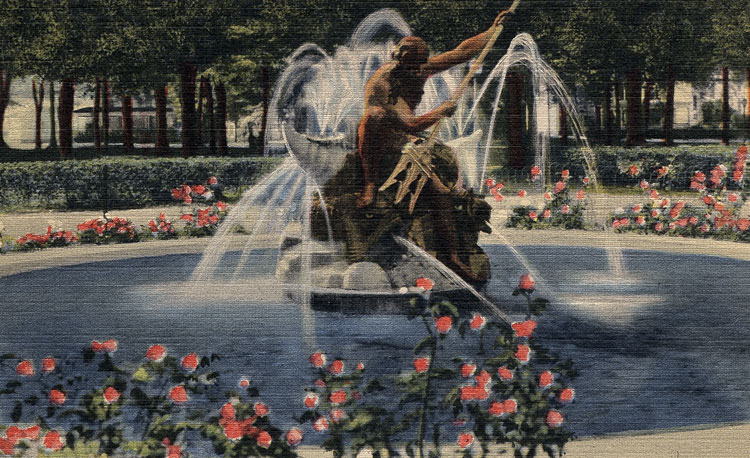
Neptune Fountain in its new home, Washington Park. Image source: private collection
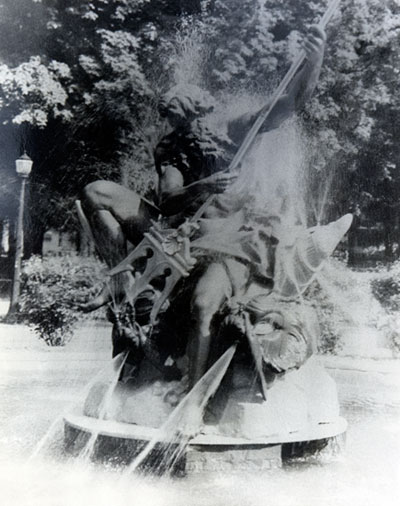
Close view of the fountain in Washington Park.
Dunkirk's Washington Park, bounded by Park, Washington, 5th and 6th streets, was a popular place for active and passive recreation. It already had a spray fountain in a wide basin, but the city replaced it with the King Neptune fountain in May, 1938. The new fountain was popularly received except by someone who complained that the flesh-tone paint made the statue seem risque. The city responded by painting it bronze.
In 1999, local resident and past Dunkirk Historical Society President Robert Harris recalled, "It was a beautiful center piece for many years. No matter where you were, you could see the fountain and the spray. It had a rose garden around the base and there were lights under the water."
Others recalled that, when playing baseball in the park, hitting the statue in the head with the ball was considered an automatic home run.
By 1967, the 84-year old statue was showing the effects of years of wear as well as the more recent damage of vandals. The mayor ordered it removed for what some citizens thought would be repair. As years went by, it languished in storage at the city water works building on Robin Street.

Debbie Ann and Cheryl Ann Harris, Memorial Day, 1967. Image credit: Dunkirk Historical Society

Neptune statue stored at Dunkirk water works building. Image credit: Dunkirk Historical Society
.jpg)
Statue prepared for moving to SUNY Fredonia for restoration..
Image credit: Dunkirk Historical Society.
In September, 1985, the city council voted unanimously to transfer owership of the the fountain statue to the Dunkirk Historical Society, which hoped to restore it. The restoration cost proved too great at the time and the statue remained in storage until 1999.
In that year, the Dunkirk Historical Society created the "King Neptune Restoration Project" and joined with the Dunkirk Rotary Club to commence raising $20,000 to restore the statue.
Professor Robert Booth, Chair of the Visual Arts and New Media Department at SUNY Fredonia, agreed to restore King Neptune at the college's facilities. He had recently completed restoration of the two Mark fountains in Fredonia's Barber Commons.
The necessary funds were raised, nearly 25% of which came from residents, social clubs, and businesses.
The statue required a great deal of work: cleaning, repairing major cracks, adding a stabilizing piece inside to support the weight, replacing of all nozzles and pipes, part of the trident and some of the sea creatures. By August, 2001, restoration was complete and King Neptune was returned to Washington Park for an afternoon's visit.
The Historical Society had insured the 118-year old statue for $100,000 and was searching for a permanent location that would be sheltered from the elements, secure from vandalism, highly visible to the community, and operational year-round. These factors suggested an indoor location.
.jpg)
Statue at SUNY Fredonia, paint removed, 2001. Image credit: Dunkirk Historical Society
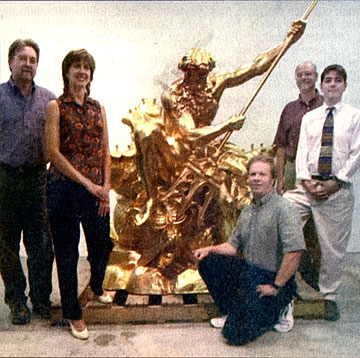
Members of the King Neptune Restoration committee, left to right: Professor Robert Booth, Diane Genung, Roger Schulemberg, Mike Sheffield, Roy Davis(kneeling).
Image credit: Dunkirk Observer, Bill Karrow.
The search for a location proved both difficult and politically fraught for the Historical Society. In the short term, Fredonia College President Dennis Hefner offered to display the statue in the new Steele Hall, which houses the college's natatorium. In late 2001, Neptune, on loan by written agreement, went on display in the lobby of that building.
The Historical Society explored placing the statue in Dunkirk's Boardwalk Market near the city pier, but no space was available. When the public library addition was planned, a request to make space in the lobby was rejected for lack of funds. Lack of funds also doomed placement in the Lake Erie Heritage Center as well as the incubator project which SUNY Fredonia located in the city of Dunkirk. The mayor of Dunkirk wanted to install the statue outside City Hall, but it was an outdoor location. Some suggested that it be placed near Dunkirk High School's new pool, but that did not meet the criteria for security or community visibility. Disputes with city leaders have cost the Historical Society its city financial support.
The statue is on loan to SUNY Fredonia.

Neptune on display, lobby of Steele Hall, SUNY Fredonia, 2012

The Washington Park fountain basin in 2013, an evergreen as its centerpiece.
There was another "Neptune" fountain in Western New York, in Akron's Russell Park. See that story here.
Special thanks to Dunkirk Historical Museum president, Diane Andrasik, and volunteer Denise Griggs for their assistance with this story.
